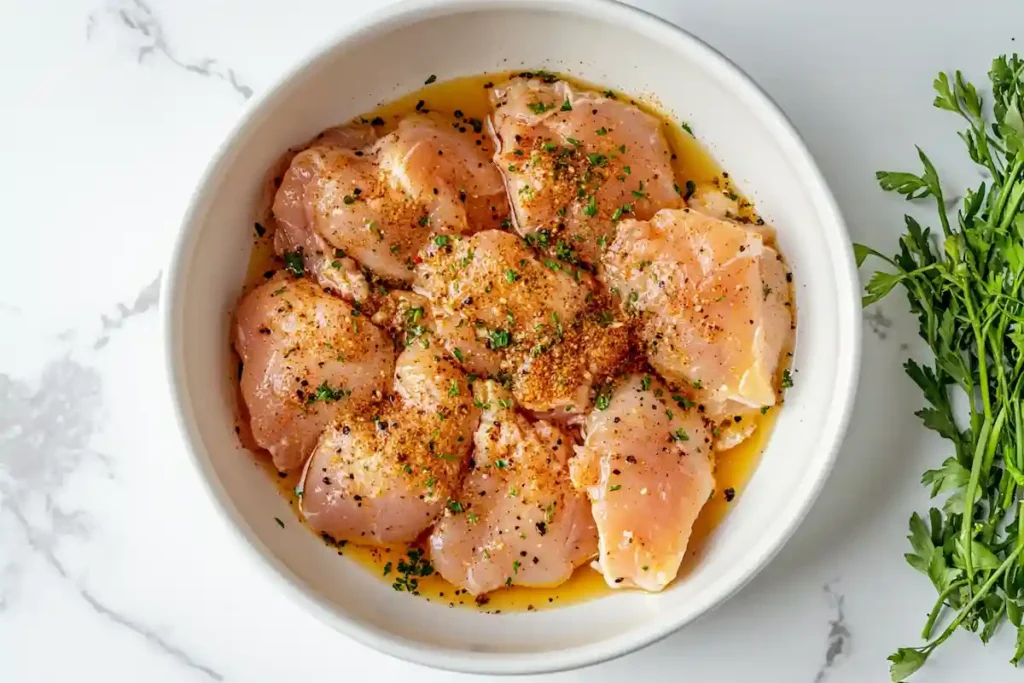Introduction
When you think of enjoying a meal featuring chicken, nothing compares to a fork-tender bite that practically melts in your mouth. In many U.S. households, chicken is a go-to protein for everything from weeknight dinners to weekend cookouts. Yet, the real magic lies in discovering how to make chicken pieces tender so that each mouthful bursts with flavor and succulence. Overcooked or rubbery chicken can ruin a perfectly planned meal, leaving you disappointed. Luckily, mastering tenderness is simpler than it looks. With the right techniques—ranging from marinades to controlled cooking temperatures—you can serve juicy chicken pieces every time.
Why Focus on Tender Chicken?
Tender chicken pieces elevate the overall eating experience. Think of biting into a piece of chicken that requires no effort to chew, releasing savory juices that enrich every morsel. It’s not just about taste; it’s also about keeping all those nutrients locked in. Dry, tough chicken signals lost moisture and flavor. By uncovering how to make chicken pieces tender, you’re learning to optimize both nutrition and taste, ensuring you deliver restaurant-quality meals in your own kitchen.
1. Why Chicken Pieces Become Tough
It’s easy to blame toughness on factors beyond our control, but in reality, most of the reasons chicken becomes tough are preventable. Understanding these reasons is the first step in discovering how to make chicken pieces tender consistently.
1. Overcooking at High Temperatures
Cooking chicken for too long or at temperatures that are too high squeezes out the natural moisture. Proteins in the chicken tighten up and lose their juices, leaving you with dry, chewy meat. This problem often occurs when people rush the cooking process or fail to monitor internal temperatures accurately.
2. Inadequate Marination
Marination is a powerful technique that adds flavor and tenderizes the meat. A short soak or skipping marination altogether prevents chicken from absorbing essential moisture and flavors. Acids, enzymes, or salt in a marinade break down muscle fibers, which is key to achieving that tender bite.
3. Improper Handling or Selection
Sometimes, the issue starts before the chicken ever meets heat. Using low-quality chicken or mishandling it during prep can lead to dryness. If you’re using frozen chicken, thawing it improperly (like letting it sit on the counter for too long) can affect its texture once cooked.
2. Essential Ingredients & Tools for Tender Chicken
Before you dive into the step-by-step process of how to make chicken pieces tender, gather the right ingredients and tools. Simplicity is fine, but certain items are crucial for optimal results.
Key Ingredients
- Fresh Chicken Pieces: Opt for higher-quality cuts if possible. Look for minimal additives or processed solutions.
- Salt: Essential for seasoning and can be used in a brine or marinade to retain moisture.
- Acidic Marinade Component: Lemon juice, lime juice, or vinegar can help break down the proteins.
- Dairy (Optional): Yogurt or buttermilk can tenderize chicken gently, especially for fried or baked recipes.
- Herbs & Spices: Garlic, onion powder, chili flakes, black pepper, rosemary, thyme—these add flavor without drying out the meat.
Recommended Tools
- Meat Thermometer: Ensures precise cooking and helps avoid overcooking.
- Shallow Dish or Resealable Bag: For marinating chicken pieces evenly.
- Slow Cooker or Dutch Oven: Great for longer cooking times at lower temperatures.
- Heavy-Bottomed Skillet: Distributes heat evenly to help the chicken cook uniformly.
- Tongs: For turning pieces without piercing them (which could release moisture).
Nutritional Information (Per 100g of Cooked Chicken)
When mastering how to make chicken pieces tender, it’s also helpful to understand its nutritional value. Chicken is an excellent source of lean protein and essential nutrients, making it a healthy addition to any meal. Below is the approximate nutritional breakdown of 100g of cooked skinless, boneless chicken breast:
| Nutrient | Amount (Per 100g) | Daily Value %* |
|---|---|---|
| Calories | 165 kcal | 8% |
| Protein | 31g | 62% |
| Total Fat | 3.6g | 5% |
| Saturated Fat | 1.0g | 5% |
| Cholesterol | 85mg | 28% |
| Sodium | 74mg | 3% |
| Iron | 0.9mg | 5% |
| Calcium | 11mg | 1% |
| Potassium | 256mg | 7% |
*Percent Daily Values are based on a 2,000 calorie diet.
3. Step-by-Step Instructions: How to Make Chicken Pieces Tender
Let’s break down the process, from selecting your chicken to plating the final dish. Whether you prefer baking, grilling, or stovetop cooking, these steps form the foundation for how to make chicken pieces tender in a variety of recipes.
Step 1: Selecting Quality Chicken Pieces
- Choose the Right Cut: Chicken breasts are leaner, which means they can dry out if overcooked. Thighs have more fat, offering extra leeway for maintaining moisture. Wings are naturally tender but have less meat, while drumsticks can also remain juicy if cooked properly.
- Fresh vs. Frozen: Fresh chicken often has better texture. If using frozen pieces, thaw them in the refrigerator overnight, not on the countertop. This preserves the integrity of the meat and reduces the risk of bacterial growth.
Step 2: Preparing the Marinade or Brine
- Choose a Marinating Base: Popular options include citrus-based marinades or dairy-based marinades. Citrus adds brightness and tang, while yogurt or buttermilk lends a subtle creaminess.
- Add Seasoning: Salt, pepper, garlic powder, onion powder, and dried herbs can be mixed in. If you prefer a spicy kick, include chili flakes or cayenne pepper.
- Consider a Salt Brine: A simpler route uses just water, salt, and optional sugar. Dissolve salt in warm water, then chill the solution before submerging your chicken. This method is especially handy for large batches.

Step 3: Marination & Brining Duration
- Marination Time: Acidic marinades typically need 30 minutes to 2 hours. Longer marination can over-tenderize the outer layer, making it mushy.
- Brine Time: Aim for 30 minutes to 12 hours, depending on the salt concentration. If you use a stronger brine, keep the time shorter to avoid excessively salty chicken.
Step 4: Cooking Techniques
Here’s where true transformation happens. Different methods can teach you new ways for how to make chicken pieces tender, each with its unique advantages.
Slow Cooking
- Process: Place marinated chicken in a slow cooker with a small amount of liquid (broth or water).
- Why It Works: Low and slow heat breaks down connective tissues, locking in moisture.
- Time & Temperature: Typically, 3-4 hours on high or 6-7 hours on low.
Poaching
- Process: Submerge chicken in simmering liquid (broth, water, or a mix of herbs and spices).
- Why It Works: Gentle heat ensures the chicken won’t toughen up.
- Time & Temperature: Keep the liquid at a low simmer (around 160-180°F). Cook until the chicken reaches 165°F internally.
Baking
- Process: Preheat your oven to 375°F (190°C). Arrange chicken pieces on a baking tray with enough space for heat circulation.
- Why It Works: Even, consistent heat. Covering the tray loosely with foil can help retain moisture.
- Time: Usually 20-30 minutes for smaller pieces, 30-40 for larger pieces. Check with a thermometer.
Pan-Searing or Grilling
- Process: Marinate the chicken, then cook in a hot skillet or on a grill to seal in juices.
- Why It Works: High-heat searing caramelizes the surface. Follow up with medium heat to cook through without drying out.
- Time: About 4-5 minutes per side, depending on the thickness of the chicken piece.
Step 5: Resting & Serving
- Rest for 5-10 Minutes: After you’ve cooked the chicken to 165°F, remove it from heat and let it rest. This step helps redistribute the juices throughout the meat.
- Slice or Serve Whole: For chicken breasts, slicing diagonally can further enhance tenderness. With thighs or drumsticks, serve them as-is and let the diner enjoy the fall-off-the-bone goodness.
4. Tips & Tricks for Juicy Chicken Every Time
- Use a Meat Thermometer: Don’t rely solely on cooking time. Chicken is safe at 165°F.
- Avoid Piercing the Meat Too Often: Use tongs instead of forks to flip chicken.
- Opt for Dark Meat: Thighs often remain more forgiving and tender than breasts.
- Balance Acidity: A marinade heavy on citrus or vinegar tenderizes effectively, but too much acid can lead to an overly soft texture.
- Try a Quick Brine: Even 30 minutes in a simple salt solution can make a world of difference.
5. Variations: Flavor Twists & Meal Ideas
Exploring different flavor combinations not only spices up your meal but also unveils multiple paths to learning how to make chicken pieces tender in creative ways.
- Garlic & Herb Chicken: Marinate with olive oil, crushed garlic, parsley, and thyme. Roast in the oven or pan-sear.
- Citrus Zest Chicken: Combine lemon juice, orange zest, and black pepper. The acid brightens flavor and tenderizes.
- Spicy Chili Chicken: Mix chili powder, paprika, and a dash of hot sauce in a yogurt marinade. Slow cook or grill for a smoky finish.
- Mediterranean-Inspired: Use oregano, basil, garlic, and a hint of lemon juice. Great for salads or wraps.
Meal Ideas
- Chicken Tacos: Shred slow-cooked chicken pieces and fill tortillas with fresh pico de gallo.
- Chicken Salad: Slice poached chicken and toss with lettuce, tomatoes, and a light vinaigrette.
- Chicken Sandwiches: Use baked chicken breasts topped with lettuce, tomato, and a creamy dressing.
- Chicken Pasta: Add sliced, tender chicken to your favorite pasta dish. The moisture from the sauce further keeps the chicken from drying out.
6. Frequently Asked Questions
Below are four top questions from People Also Ask (PAA), each shedding light on how to make chicken pieces tender in specific scenarios.
1. How to Make the Chicken Soft and Tender?
Making chicken soft and tender involves two critical components: proper marination and controlled cooking. Whether you opt for a salt brine or a yogurt-based marinade, the goal is to break down the muscle fibers gently. Cook your marinated chicken at moderate heat and avoid overcooking. Once it reaches an internal temperature of 165°F, let it rest for about 5 minutes. This approach keeps the meat juicy and prevents it from turning rubbery.
2. How Do You Tenderize Chicken Pieces?
You can tenderize chicken pieces using acidic marinades, salt brines, or physical methods. For marinades, ingredients like lemon juice, vinegar, or buttermilk help break down proteins. Salt brining locks in moisture and adds flavor. If you’re short on time, a quick mechanical tenderizing approach—like gently pounding the chicken with a mallet—also works. Each method aims to soften muscle fibers and create a more succulent bite.
3. How Do You Cook Chicken Pieces Without Drying Them Out?
Focus on moderate cooking temperatures and shorter cooking times for smaller pieces. Use a thermometer to ensure the internal temperature hits exactly 165°F. Overcooking at high heat is a recipe for dryness. Another tip is to sear the chicken first, then reduce the heat or transfer it to the oven to cook through more gently. Covering the pan or baking dish for part of the cooking process can also help retain moisture.
4. How Do You Make Chicken Not Rubbery and Tender?
Chicken often becomes rubbery when it’s cooked too quickly at high heat or for too long. Avoid these pitfalls by marinating, brining, or even poaching the chicken at a lower simmer. Keep an eye on internal temperature and don’t skip the resting period. This allows the juices to redistribute, ensuring each piece stays tender and far from rubbery.
7. Common Mistakes to Avoid

Many people struggle with how to make chicken pieces tender because they commit a few classic errors. By sidestepping these pitfalls, you can significantly improve your final dish.
- Skipping the Marinade: Even a 20-minute soak can help. Going without any marination usually results in under-flavored meat.
- Using Too Much Acid: While acids are beneficial, overdoing them can degrade the texture into a mushy consistency.
- Cranking Up the Heat: High heat quickly removes moisture. Instead, use moderate heat or consider methods like poaching and slow cooking.
- Forgetting to Rest: Cutting into chicken immediately can cause the savory juices to escape, leaving dryness behind.
8. Expert Insights & Pro Tips
Learning how to make chicken pieces tender doesn’t end with the basics. The following advanced strategies offer an edge when you want the best possible results.
- Baking Soda Method
- Lightly coat chicken pieces with a small amount of baking soda.
- Let it sit for 15-20 minutes, then rinse and pat dry.
- This technique raises the pH of the meat’s surface, making it harder for the proteins to bond and helping the chicken stay tender.
- Layer Your Flavors
- For advanced marination, combine layers of flavor: a base marinade (like lemon or yogurt), plus a secondary coating of herbs or spices.
- This layering ensures multiple dimensions of taste.
- Use Compound Butters
- While cooking, baste or finish the chicken with a bit of flavored butter (garlic or herb).
- The butter’s fat content locks in moisture and lends a deeper flavor profile.
- Sous Vide Precision
- If you have sous vide equipment, vacuum-seal seasoned chicken and cook it at a precise lower temperature (around 145°F to 150°F), then finish with a quick sear.
- This prevents the meat from losing moisture and delivers a uniform tenderness.
Conclusion
If you’ve ever wondered how to make chicken pieces tender, now you have a complete toolkit of methods at your disposal. From marinating in dairy-based solutions to choosing the right cooking techniques—such as slow cooking or poaching—each step is designed to protect and enhance the chicken’s natural juices. Brining, controlling your heat, and letting the meat rest are additional layers of assurance that guarantee soft, flavorful results. Even small tweaks, like selecting high-quality chicken or using a meat thermometer, can transform a standard meal into a restaurant-worthy dish.
Beyond technique, tenderizing chicken is also about understanding how flavors and textures interact. The beauty of these methods is that they are versatile and customizable—whether you prefer bold, spicy marinades or mild, herbed brines, you can adapt each step to match your taste. Cooking chicken isn’t just a science; it’s an art that allows you to experiment, refine, and improve over time.
Remember, practice makes perfect. Don’t be afraid to test different methods, adjust seasonings, or explore new combinations. Try pairing your perfectly tender chicken with complementary sides like roasted vegetables, fresh salads, or a rich, savory sauce to elevate your meal even further.
By incorporating these techniques into your cooking routine, you’ll never have to settle for dry, tough chicken again. Instead, you’ll consistently create meals that are juicy, flavorful, and satisfying. So go ahead—embrace these tips, enjoy the process, and serve tender chicken pieces with confidence whenever you please!
Print
Chicken Pieces Tender Recipe
- Total Time: 45 minutes
- Yield: 4 servings 1x
Description
Achieving tender, juicy chicken pieces is a culinary delight that enhances any meal. This recipe guides you through marinating chicken in a flavorful blend of yogurt, lemon juice, and aromatic spices, followed by a gentle baking process. The result is succulent chicken with a delightful depth of flavor, perfect for any occasion.
Ingredients
- 1 kg chicken pieces (thighs, drumsticks, or breasts), skinless
- 1 cup plain yogurt
- 2 tablespoons fresh lemon juice
- 4 cloves garlic, minced
- 1 teaspoon ground cumin
- 1 teaspoon paprika
- 1/2 teaspoon ground turmeric
- 1/2 teaspoon ground black pepper
- 1 teaspoon salt
- 2 tablespoons olive oil
- Fresh cilantro or parsley, chopped, for garnish
Instructions
- Prepare the Marinade: In a large bowl, combine the yogurt, lemon juice, minced garlic, ground cumin, paprika, turmeric, black pepper, and salt. Mix well to form a smooth marinade.
- Marinate the Chicken: Add the chicken pieces to the bowl, ensuring each piece is thoroughly coated with the marinade. Cover the bowl with plastic wrap and refrigerate for at least 1 hour, preferably overnight, to allow the flavors to penetrate and tenderize the meat.
- Preheat the Oven: When ready to cook, preheat the oven to 190°C (375°F).
- Arrange the Chicken: Lightly grease a baking dish with olive oil. Place the marinated chicken pieces in the dish in a single layer, ensuring they are not overcrowded. Drizzle a tablespoon of olive oil over the top of the chicken.
- Bake the Chicken: Bake in the preheated oven for 25-30 minutes, or until the chicken is cooked through and reaches an internal temperature of 75°C (165°F). The juices should run clear when the meat is pierced with a knife.
- Rest and Serve: Once cooked, remove the chicken from the oven and let it rest for 5 minutes. Garnish with freshly chopped cilantro or parsley before serving.
Notes
- Marinating Time: For optimal tenderness and flavor, marinate the chicken overnight. However, if time is limited, a minimum of 1 hour will still yield good results.
- Alternative Cooking Methods: This recipe is versatile and can be adapted for grilling or pan-frying. Adjust cooking times accordingly to ensure the chicken is thoroughly cooked.
- Serving Suggestions: Pair the tender chicken pieces with a side of steamed vegetables, rice, or a fresh salad for a complete meal.
Note: Nutritional values are approximate and may vary based on specific ingredients used.
Enjoy your tender and flavorful chicken pieces!
- Prep Time: 15 minutes
- Cook Time: 30 minutes
- Category: Lunch
- Method: Baking
- Cuisine: International
Nutrition
- Serving Size: Approximately 250g of chicken
- Calories: 320
- Sugar: 3g
- Sodium: 620mg
- Fat: 18g
- Saturated Fat: 4g
- Carbohydrates: 5g
- Fiber: 1g
- Protein: 35g
- Cholesterol: 110mg
Keywords: Tender chicken, marinated chicken, baked chicken, juicy chicken pieces

